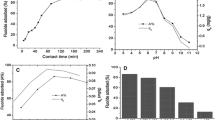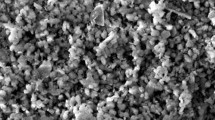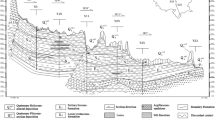Abstract
Rare earth mineral based adsorbent viz. lanthanum oxide was investigated for potential application in defluoridation of drinking water for isolated and rural communities. Results of batch experiments indicated about 90% removal in 30 min from a 4 mg L−1 synthetic fluoride solution. The effects of various parameters like contact time, pH, initial concentration, and sorbent dose on sorption efficiency were investigated. Adsorption efficiency was dependent on initial fluoride concentration and the sorption process followed BET model. Variation of pH up to 9.5 has insignificant effect on sorption and beyond a pH of 9.5, the effect was drastic. Among anions investigated, carbonates exhibited high detrimental effect on fluoride adsorption while anions like bicarbonates, chlorides, and sulfates did not seriously affect the process. Adsorbent showed negligible desorption of fluoride in distilled water. Alum was more effective regenerant than HCl and NaOH. Results of cyclic regeneration with alum indicated that the sorbent could be regenerated for ten cycles without significant loss of sorption capacity. Studies with upflow fixed-bed continuous flow columns indicated the usefulness of sorbent for fluoride removal in continuous flow process.














Similar content being viewed by others
References
Alexander, F., & McKay, M. (1977). Kinetics of the removal of basic dye from effluents using silica (Part I). Chemical Engineer, 31(9), 243.
APHA. (1995). Standard Methods for Examination of Water and Wastewater (19th ed.). Washington: APHA, AWWA, WEF.
Bhakuni, T.A. (1970) Studies on removal of Fluorides from drinking water by different ion exchange materials developed indigenously, Ph.D. Thesis, University of Nagpur, Nagpur, India.
Bishop, P. L. & Sansoucy, G. (1978). Fluoride removal from drinking water by fludized activated alumina. J American Water Works Association, 70(10), 554–558.
Boruff, C. S. (1934). Removal of fluorides from drinking water. Industrial and Engineering Chemistry, 26(1), 69–71.
Brunauer, J., Emmett, P. H., & Teller, E. (1938). Adsorption of gases in multimolecular layers. Journal of the American Chemical Society, 60, 309.
Bulusu, K. R., & Pathak, B. N. (1969). Fluorine—It’s Effect on Human Health and Defluoridation of Water—Methods and Their Limitations. Nagpur: National Environmental Engineering Research Institute Report.
Bulusu, K. R., Sundaresan, B. B., Pathak, B. N., Nawlakhe, W. G., Kulkarni, D. N., & Thergaonkar, V. P. (1979). Fluoride in water, defluoridation methods and their limitations. J. Institution of Engineers (India). Environmental Engineering Division, 60, 1–25.
Bureau of Indian Standards: IS 10500–1991. Drinking Water Specifications, Third Reprint, 1996, Bureau of Indian Standards, New Delhi, India
Chen, D. Z., Zhang, J. X., & Chen, J. M. (2010). Adsorption of methyl tert-butyl ether using granular activated carbon: Equilibrium and kinetic analysis. Int. J. Environ. Sci. Tech., 7(2), 235–242.
Crank, J. (1965). The Mathematics of Diffusion. London: Clarendon.
Davis, J. A., & Leckie, J. O. (1980). Surface ionization and complexation at the oxide/water interface. J. Colloid and Interface Science, 74(1), 32.
Fink, G. J., & Lindsay, F. K. (1936). Activated alumina for removing fluorides from drinking water. Industrial and Engineering Chemistry, 28(80), 947–948.
Giles, C. H. (1970). Interpretation and use of sorption isotherms. Sorption and Transport in Soils, S.C.I. Monograph No.37. London: Society of Chemical Industry.
Gupta, G. S., Prasad, G., Pandey, K. K., & Singh, V. N. (1988). Removal of chrome dye from aqueous solutions by fly ash. J Water, Air, and Soil Pollution, 37, 13.
Helfferich, F. (1962). Ion Exchange. New York: McGraw-Hill Book Company Inc.
Hendricks, D. W., & Kuratti, L. G. (1982). Derivation of an empirical sorption equation by analysis of experimental data. Water Research, 16(6), 829.
Imai, H., Nomura, J., Ishibashi, Y., & Konishi, T. (1987). Nippon Kagaku Kaishi, 5, 807.
Islam, M., Mishra, P. C., & Patel, R. (2010). Fluoride adsorption fromaqueous solution by a hybrid thorium phosphate composite. Chemical Engineering Journal, 166(3), 978–985.
Jiao, Z., Zhang, Y., Yang, M., Huang, X., & Ma, Ke-Min. (2002). Removal of Fluoride using rare earth based inorganic adsorbent, State Key Lab. of Environmental aquatic chemistry, Research Center for Eco-Environmental Science, Chinese Academy of Sciences, Beijing, China. Huanjing Huaxue, 21(4), 365–370.
Karthikeyan, J. (1982) Enhancement of mercury (II) removal by coal through Chemical treatment, M.Tech. Thesis, Dept. of Civil Engineering, IIT, Kanpur, India.
Kaufhold, S., Dohrmann, R., Abidin, Z., Henmi, T., Matsue, N., Eichinger, A., et al. (2010). Allophane compared with other sorbent minerals for the removal of fluorides from water with a particular focus on a minerable Ecuadorian allophane. Applied Clay Science, 50(1), 25–33.
Kenesato, M., Yokoyama, T., & Suzuki, T. (1988). Chemical Letter, 2, 207.
Killedar, D. J., & Bhargava, D. S. (1988a). An overview of defluoridation methods (Part I). J Institute of Public Health Engineers (India), 1988(1), 6–13.
Killedar, D. J., & Bhargava, D. S. (1988b). An overview of defluoridation methods (Part II). J Institute of Public Health Engineers (India), 1988(2), 37–44.
Kulkarni, D., & Nawlakhe, G. W. (1974). Serpentine—Its limitations as a defluoridation medium. Indian J. of Environmental Health, 16, 151.
McKay, G. (1980). Color removal by adsorption. American Dyestuff Reporter, 67(3), 38.
McKay, G., Otternburn, M. S., & Sweeney, A. G. (1980). The removal of color from effluent using various adsorbent-III silica: Rate processes. Water Research, 14, 15.
McKee, R. H., & Jhonston, W. S. (1934). Removal of fluorides from drinking water. Industrial and Engineering Chemistry, 26(8), 849–850.
Michelson, L.D., Gideon, P.G., Pace, E.G. and Kutat, L.H. (1975). Removal of soluble mercury from wastewaters by complexing technique, Bulletin No. 74, USDI Office of Water Research and Technology.
Mlilo, T. B., Brunson, L. R., & Sabatini, D. A. (2010). Arsenic and fluoride removal using simple materials. J. Environmental Engineering Division, ASCE, 136(4), 391–398.
Muthukumaran, K. (1995) Studies on chemically activated carbon for the removal of trace inorganics from water, Ph.D. Thesis, Dept. of Chemistry, IIT, Madras, India.
Nawlakhe, W. G., Kulkarni, D. N., Pathak, B. N., & Bulusu, K. R. (1975). Defluoridation of water by Nalgonda Technique. Indian Journal of Environmental Health, 17(1), 26.
Raichur, A. M., & Jyothi Basu, M. (2001). Adsorption of fluoride onto mixed rare earth oxides. Separation and Purification Technology, 24, 121–127.
Savinelli, E. A., & Black, A. P. (1958). Defluoridation of water with activated alumina. J American Water Works Association, 50(1), 33–44.
Smith, H. V., & Smith, H. C. (1937). Bone contact removes fluorides. Water Works Engineering, 97(1), 990.
Swope, G. H., & Hess, R. H. (1937). Removal of fluoride from natural water by deFluoride. Industrial and Engineering Chemistry, 29(40), 424–426.
Tokunaga, S., Hakuta, T., & Wasay, S. A. (1999). Journal of the National Institute of Materials and Chemical Research, 7(6), 291–334.
Venkata Mohan, S., & Karthikeyan, J. (1997). Removal of lignin and tannin colour from aqueous solution by adsorption onto activated charcoal. Environmental Pollution, 97(1–2), 183–187.
Weber, W. J., Jr. (1972). Physicochemical processes for water and quality control. New York: Wiley Inter Science.
Author information
Authors and Affiliations
Corresponding author
Rights and permissions
About this article
Cite this article
Rao, C.R.N., Karthikeyan, J. Removal of Fluoride from Water by Adsorption onto Lanthanum Oxide. Water Air Soil Pollut 223, 1101–1114 (2012). https://doi.org/10.1007/s11270-011-0928-0
Received:
Accepted:
Published:
Issue Date:
DOI: https://doi.org/10.1007/s11270-011-0928-0




